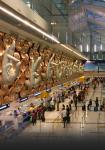Rates to stay low for long
Kishlaya Pathak, Economist-India, Standard-Chartered Bank
The Reserve Bank of India signalled a stable interest rate scenario in its latest monetary policy statement. The repo rate has bottomed out and the next big call is on the timing of the first rate hike by the RBI.
However, tightening is unlikely well into the future, at least till the first half of 2005. We also expect liquidity to remain robust in the year ahead. This scenario should support the bond market even as the incipient recovery in investment demand gathers momentum in the second half of the year. The bond market is likely to range trade and a secular rise in yields looks unlikely.
This view is based on four basic pillars. One, the rate hikes in the US will be modest. Two, generalised dollar weakness and the "IT revolution" would underpin the rupee's strength. Three, higher growth domestically may not necessarily lead to spiralling inflation. Four, the way forward for India is fiscal consolidation, which has implications for the conduct of monetary policy.
The US Federal Reserve is set to raise rates this month. We expect Fed Funds rate to rise to 2 per cent by 2004 end and to 3 per cent by 2005-end. We expect a post-election slowdown in the US as the budget stimulus fades away. Growth should slowdown from 5 per cent in 2004 to about 3 per cent in 2005, capping inflation.
The dollar is likely to continue to weaken, weighed down by the twin deficits -- current account and budget. However, we expect the dollar weakness cycle to "broaden". The next round of dollar weakness is likely to be against the Asian currencies.
Oil prices should eventually settle down around $35 a barrel, US rates would probably not rise by as much as the markets expect and the Chinese authorities should be able to engineer a soft landing. As a result of all these the Asian currencies will strengthen.
Indian industrial growth is picking up sharply with output growing 9.4 per cent year-on-year in April. However, there is little evidence of demand-pull inflation yet. Domestic oil prices will certainly rise but countering this would be a moderation in internationally transmitted commodity price pressures.
The past link between growth and inflation would probably not hold this time around. Global inflation has fallen sharply over the '90s. Increasing globalisation and liberalisation of the Indian economy in the '90s implies intense competition, which has reduced pricing power significantly.
Last but not least, though there is no direct survey evidence, inflation expectations would have declined, driven by persistently low actual inflation over the last few years. On balance, inflation should average around 5 per cent in the fiscal year ahead.
Finally, the key theme defining financial markets over the next few years is likely to be fiscal consolidation. In many ways, it is a now or never choice for the government, as strong growth will provide it with a unique opportunity to balance its books.
Though it is not immediately evident how the public will respond to tax reforms, a reasonable scenario is that this process could have a moderating impact on growth and inflation. It is crucial to ensure a robust revival in private investment demand.
Given the above, monetary policy will have to be extremely accommodative for an extended period and rates will remain low for longer than the market currently expects.
Aberrations in short run likely
B K Piparaiya, General Manager, Bank of Maharashtra
Every time interest rates fell in India over the last five years, it looked like they bottomed out. Will they rise now?
The contributing factors of a free fall in the past such as sound economic fundamentals, continued foreign inflows, and ample liquidity in the system still rule.
Yes, the rigidity in employees provident fund and small savings rates, expectations of inflationary pressures owing to, high cost of energy, fiscal condition of states, present recovery in the domestic economy coupled with the government borrowing, subsidies and political instability, could at some point of time exert upward pressure on inflation and, consequently, interest rates, as argued.
The country's fiscal position is still sound. The revised estimates of 2003-04 show net decrease in expenditure, increase in net tax and non tax revenues, higher divestment receipts compared with budget estimates, lower fiscal and revenue deficit at 4.8 per cent and 3.6 per cent of estimated gross domestic product.
There are adequate forex reserves, average inflation was 4.6 per cent during the last four years and manageable fiscal deficit 4.4 per cent and revenue deficit 2.9 per cent of GDP for 2004-05 (estimated).
Liquidity remains extremely comfortable on the back of increased ways, means and advances withdrawal and the money supply is projected at reasonable level of 14 per cent by RBI.
Interest rates in the agriculture sector are likely to fall on popular demand to make farm credit cheaper.
On the external front, the hike in rates abroad (recently Bank of England jacked up its repo rate by 0.25 per cent and similar expectations from US and other developing countries) is causing concern of a possible rise in interest rates in India.
Indian conditions are, however, not similar. Hike in these countries is in short-term rates and in India short-term rates are relatively higher. The 91-day and 1-year T-bill yields are lower than overnight and repo rate. The difference between 1 year and 10-year yield is only 1 per cent against more than 2 per cent abroad.
The low current account deficit and huge exchange reserves will facilitate good exchange rate management. The possibility of rise in yields in India on this account is, therefore, low.
Coming to inflation, it was down to a 35-week low of 4.2 per cent as measured as annual gain in wholesale prices. Energy prices accounting for 14 per cent of wholesale price index are a major factor for inflation outlook.
Petroleum prices may cause inflationary pressures particularly with the depreciation of rupee. However, the government is likely to announce some petro package, to insulate customers from price shocks.
Summing up, with top-notch economic positions of the country manned by professionals and efficient handling of supply management, the outlook remains stable for interest rates and inflation barring some temporary aberrations in the short run.
They may move sideways by quarter to half a per cent and nothing to panic. There may be volatility in interest rates but not rise. The exchange rate, the political stability in the country and event risk are areas to watch out for.





 © 2025
© 2025